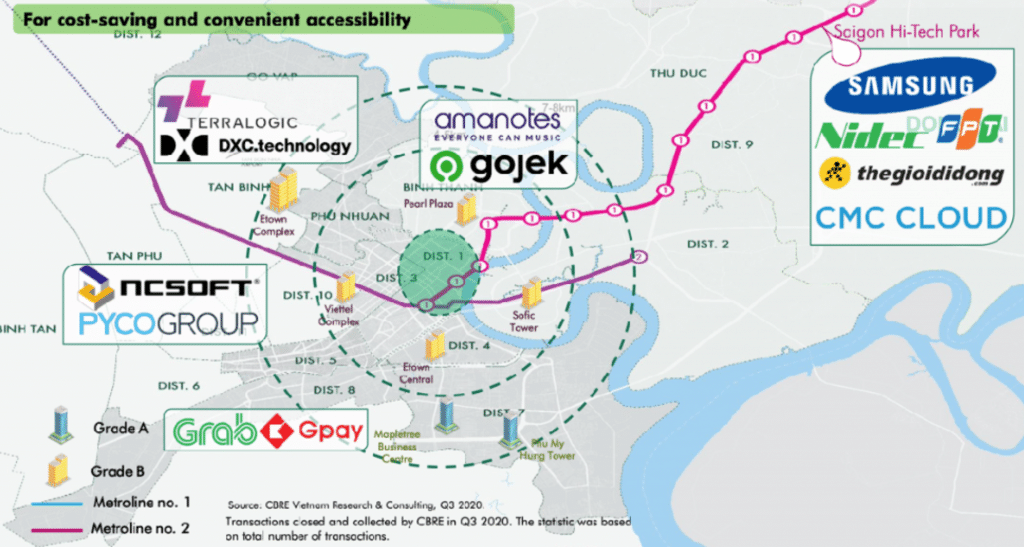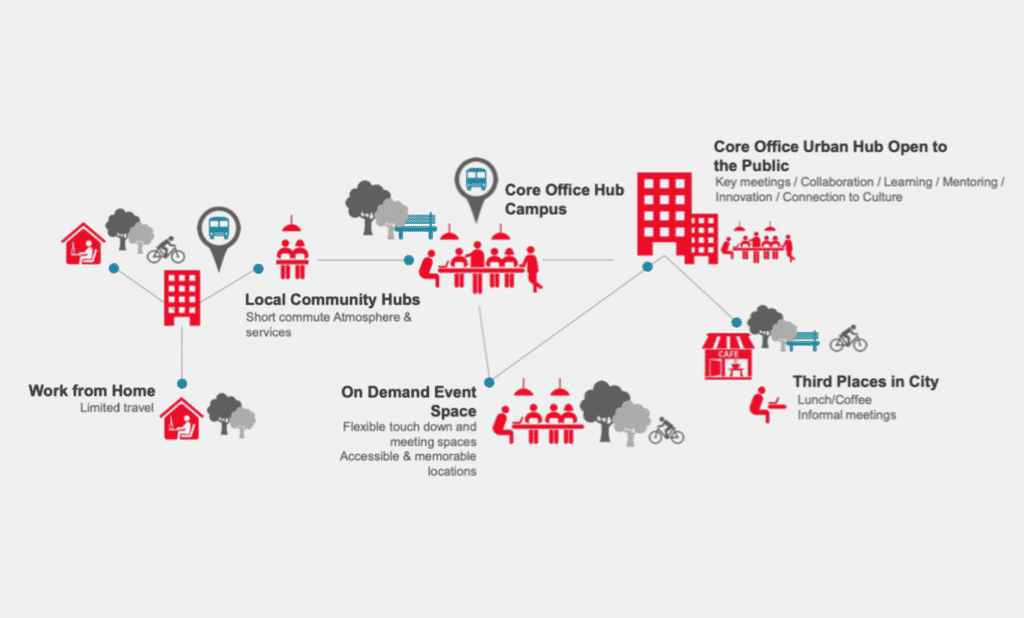Work from Anywhere is a new phenomenon that is being adopted by some of the most progressive companies in the world. In this article, we will dive into what Work from Anywhere is, why it’s beneficial, how it will impact both your employee experience and your office, and how it can be brought to life.
But before we start this journey into the future of work, we need to start with an acknowledgment. The acknowledgment that the office is no longer the workplace. There is work done in the office, but work is done in many places. In a post-COVID workplace, both employees and employers learned that they can work from anywhere.
Vietnamese employees longed for more flexibility of where to work for a while now. Even before COVID, flexible work was at the top of Vietnamese workers’ wish lists.¹ But during the social isolation in April 2020, many realized they missed the office.² Not in the last place because many employees’ homes are not at all set up for remote working, at least not all the time. So for employees, it became clear that a mix of home and office would be the preferred way of working in 2021.
For companies, there seemed to be a similar story. Before the social isolation, few companies were keen on allowing remote work. Yet during the pandemic, they learned that business continued as usual. Even with employees working from home. And, that giving employees more flexibility actually has very positive effects, not in the last place for financial reasons. So it’s not a surprise that most CFOs plan to move at least 5% of their office workers to remote positions.3
This year, forward-looking companies, therefore, offer employees the best of both worlds. The new way of work is best explained through a simple formula. The company headquarters (HQ) will be combined with remote work (at home (WFH) or near home (WNH), for example in a flex space). In short: “Work from Anywhere” (WFH.)
In short: HQ + WFH + WNH = Work From Anywhere
Currently, most companies put every workplace requirement into one physical space (“the office”). This includes places to have meetings, places to socialize, and places for focused work. As well as a place to have lunch together, a place for brainstorms, and a place for big town halls.
With more employees working from or near home, we now see companies “unbundling the office”. As workplace strategist Liz Burow says: “Work is about work “enabled” spaces, not about an office.” “Unbundling” the office means that we can take all the various roles of a traditional office, and find the best place, space, or location for them.
This means employees can do their best work by giving them more choice and flexibility in how they want to work. For example, by choosing to work from home or in an office space near home to do focused work. Or to go to a nearby collaboration space to meet colleagues and work on a project together. Or to go to the head office for important team meetings.
Across studies, we see that there are three key benefits to working from home:
Additionally, when employees come into the office selectively, they are more productive. Employees who use the office only one or two days a week (3-4 days remote is optimal for employee engagement)7, make sure those days are useful. With clear purpose, employees avoid going to the office just to sit at a desk and toggle aimlessly between emails and meetings.

Liz Burow: Work can happen anywhere. Where do I choose to work?
But the benefits don’t stop there. Pre-COVID, the average desk was used less than 60% of the time.8 That means that 40% of the space companies pay for every single day remains unused. COVID and the move towards more flexibility will further drive this down. Some estimate desk utilization to be less than 30%.9
Distributed work puts up to 2.3 employees in each workplace.10 Some companies have made inroads towards this way of using their office space. Take Nielsen Vietnam. They mix dedicated desks with hot desks. Giving space to both employees who need a permanent space, and more flexible workers.
Just like Working From Home, Working Near Home is another win-win opportunity for companies and employees alike.
HQs are often in more expensive districts. No wonder then, that we see businesses moving (parts of) their companies outside of District 1.11 Instead, they choose decentralized office buildings in more residential areas. Having the office near where employees live minimizes travel time and supports work/life balance. While saving the companies money along the way.
There, they move into areas where their employees live – cutting down on their travel time and supporting their work/life balance. And, saving the company costs along the way.

CBRE: Offices are starting to move towards where people live, supporting Work Near Home
With employees all over the city, however, companies usually still can’t be near all of them. This is why many co-working providers have expanded their locations to residential areas.12 Giving employees access to those centers means they can work amongst others without a long commute. It’s “Work Near Home.”
Like offering Work From Home, Work Near Home at flexible offices can be a great tool to attract & retain talent. Offering the best of an office without the travel time, coworking is proven to create more effective and happier employees.13 Already, 80% of enterprises in Vietnam look to increase their use of flexible offices.14
Coworking spaces and flexible office providers like Dreamplex especially deliver “Work from Anywhere” benefits for:
This “hub and spoke,” or “hub and club” model, allows employees to “work near home” at times, and be at the larger headquarters location only when it’s needed. Companies can create a network of places and spaces to work, offering complete flexibility to their employees.15 Instead of employees coming to the office, the office comes to them.
This graphic from a Cushman & Wakefield whitepaper shows more ways to unbundle the office. Working from Home and Working Near Home can be combined with on-demand event spaces. Companies no longer need to have boardrooms or training centers in their offices. These large are often unoccupied, even more so than assigned desks. Instead, companies can rent meeting rooms and event spaces by the hour, only when they need it.

Cushman & Wakefield: a vision of the “unbundled office” to support Work from Anywhere
Real estate broker JLL stated that in a post-COVID world, “demand for flexible space will not only return, but increase, as occupiers embrace flexible models more widely. We expect 30% of all office space to be consumed flexibly by 2030.” This encompasses a spectrum of office needs, from traditional HQ all the way to individual desks by the hour.16
This is especially true for enterprises. Once offices reopened, 90% of new business inquiries at Singaporean workplace provider Justco came from large companies.17 5 million people will work from coworking spaces by 2024 – a 158% increase compared to 2020.18 This is in large part due to enterprises like Microsoft, IBM, and Tencent.
These large employers can now offer their teams workspaces where and when they need them. At the same time, their employees gain access to innovators, and increased productivity. And because enterprises spend such a large amount of money on big offices, the flexibility creates even bigger savings.19
In February 2021, Spotify headlined newspapers when it announced it would adopt a full “Work from Anywhere” program for its 4,400 employees. In a statement, it said that “work isn’t something you come to the office for, it’s something you do. And effectiveness can’t be measured by the number of hours people spend in an office. Instead, giving people the freedom to choose where they work will boost effectiveness.”20
Now, Spotify team members can work full-time from home, from a nearby coworking space, from the office, or a combination of the three. The exact mix of home, coworking, and office work is a decision each employee and their manager make together. Each employee also has the freedom to choose what country and city they want to work from. Employees who live far away from any office or have a role that doesn’t require office work, are even allowed to switch to full-time remote work.
Salesforce issued a similar statement for its 54,000-person workforce to be “flex” employees, meaning they’ll only come into the office one to three days per week “for team collaboration, customer meetings, and presentations.”21 The other days, they can work from home or a coworking space near them (for which Salesforce foots the bill.)
The benefits of working from home, working near home, and a redesigned HQ are clear. We believe that the combination of these three elements, or “Work from Anywhere,” will be the future.
Never before was there such a clear win-win. Work from Anywhere enhances the Employee Experience while increasing productivity and cost savings for the company. Early research shows positive results for Work from Anywhere programs. About two-thirds of employees in these programs are satisfied with the impact on their individual performance. Additionally, 80% feels it has positively affected their team performance.
Of course, just because a handful of leading companies have made the leap doesn’t mean it is right for everyone. Or that we have all the answers. Led by people-centric CEOs and strategic HR leaders, Work from Anywhere will be a learning journey. Google echoed this in their announcement of a WFA program.
The internet giant says it will test a “flexible workweek” with three days a week in the office and other days at home. Acknowledging the experimental nature, CEO Sundar Pichai wrote to his team. “We are testing a hypothesis that a flexible work model will lead to greater productivity, collaboration, and well-being. No company at our scale has ever created a fully hybrid workforce model, so it will be interesting to try.”22
Thinking through if and how to implement a Work from Anywhere strategy? Microsoft may be of guidance in terms of a starting philosophy. The software giant with over 160,000 employees worldwide encapsulated its remote work policy in one single line: “Offer As Much Flexibility as Possible.”23
—
This is a preview of our upcoming whitepaper about the Vietnamese Workplace in 2021. It is based on a detailed panel study of Vietnamese employees and interviews with over 50 national and international HR leaders, business leaders, and workplace experts. If you haven’t yet, subscribe to our exmonthly newsletter to receive an update as soon as the whitepaper is available for download.
—
Sources:
Lead visual credit: Liz Burow, The Future of Hybrid Work: Part 2.
1. Navigos Search, “Recruiting trends 2020: Ways to find talented senior employees,” November 2019
2. Dreamplex, Online Survey, May 2020
3. Gartner, “CFO Actions in Response to COVID-19,” April 2020
4. Gallup, “Is Working Remotely Effective? Gallup Research Says Yes,” January 2020
5. Nicholas Bloom, Stanford University, “Does Working From Home Work? Evidence From A Chinese Experiment,” March 2015
6. Navigos Search, “Recruiting trends 2020: Ways to find talented senior employees,” November 2019
7. Alex Turner and Will Wilson, “The Hybrid Model Breakdown: Opportunities for Corporations,” January 2021
8. JLL, “Occupancy Benchmarking Guide 2019-2020,” 2020
9. Workplace Insight, “Unused office space could cost London businesses almost £13 billion,” November 2020
10. Knoll Workplace Research, “The Metrics of Distributed Work,” 2011
11. CBRE Vietnam, “HCMC Office Update,” October 2020
12. Channelnewsasia, “Commentary: Co-working spaces look pretty attractive right about now,” December 2020
13. Gensler, “U.S. Workplace Survey 2019.” N=6000
14. IDC and WeWork, “Future of Work: Coworking for Enterprises”, June 2020
15. Cushman & Wakefield, “Leveraging Data to Reimagine How and Where The World Will Work,” June 2020
16. JLL, “The impact of COVID-19 on flexible space,” July 2020
17. S&P Global, “GIC-backed JustCo sees rising demand from enterprises for coworking space,” December 2020
18. Coworking Resources, “2020 Global Coworking Growth Study,” March 2020
19. Vents Magazine, “Why Large Companies are Choosing Coworking Space,” February 2021
20. Spotify HR Blog, “Introducing Working From Anywhere,” February 2021
21. Brent Hyder, Salesforce, “Creating a Best Workplace from Anywhere, for Everyone,” February 2021
21. Knoll Workplace Research, “The Metrics of Distributed Work,” 2011
22. NBC News, “Google delays return to office, announces plan to test ‘flexible work week’,” December 2020
23. Kathleen Hogan, Microsoft, “Embracing a flexible workplace,” October 2020
WORK FROM ANYWHERE